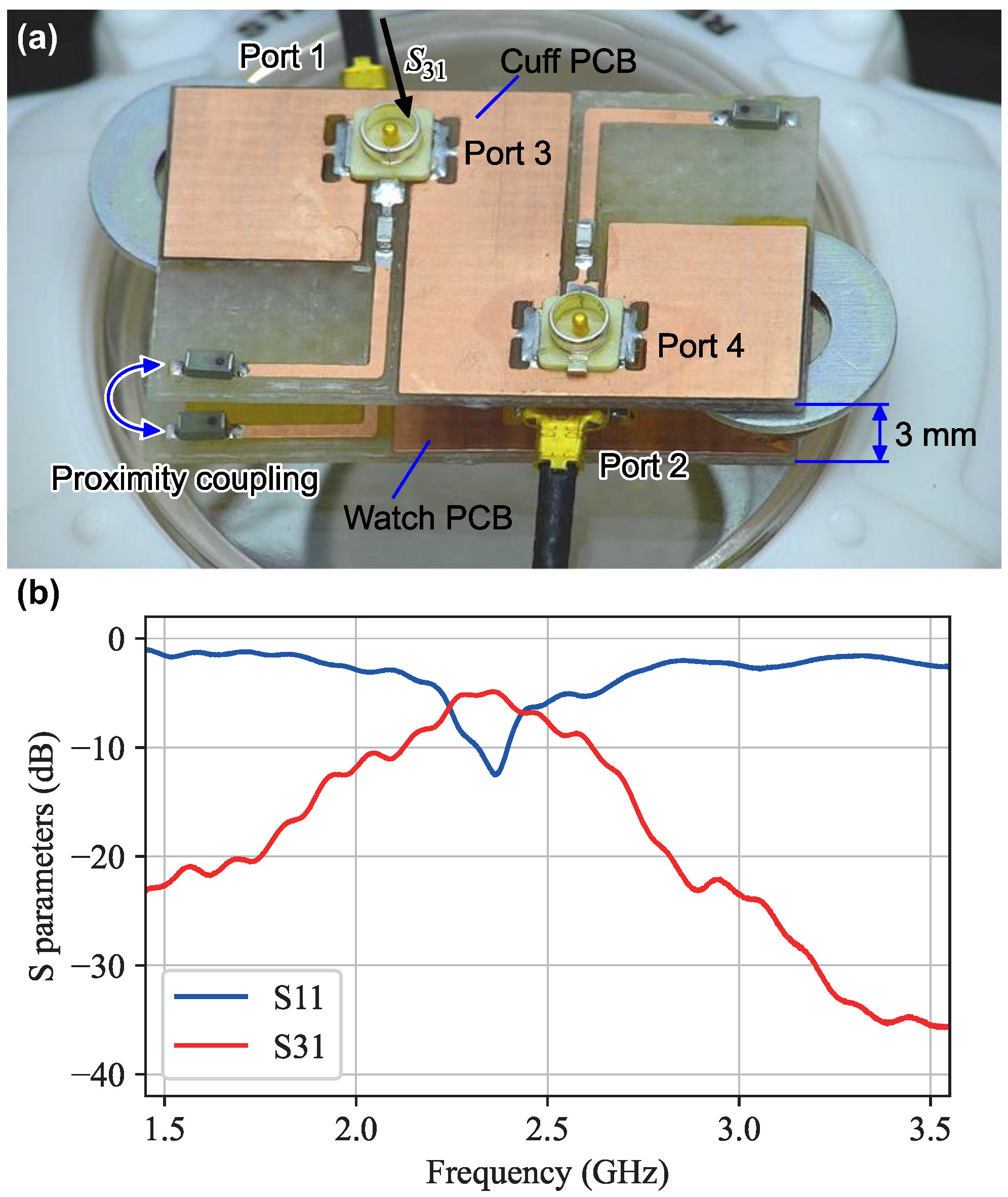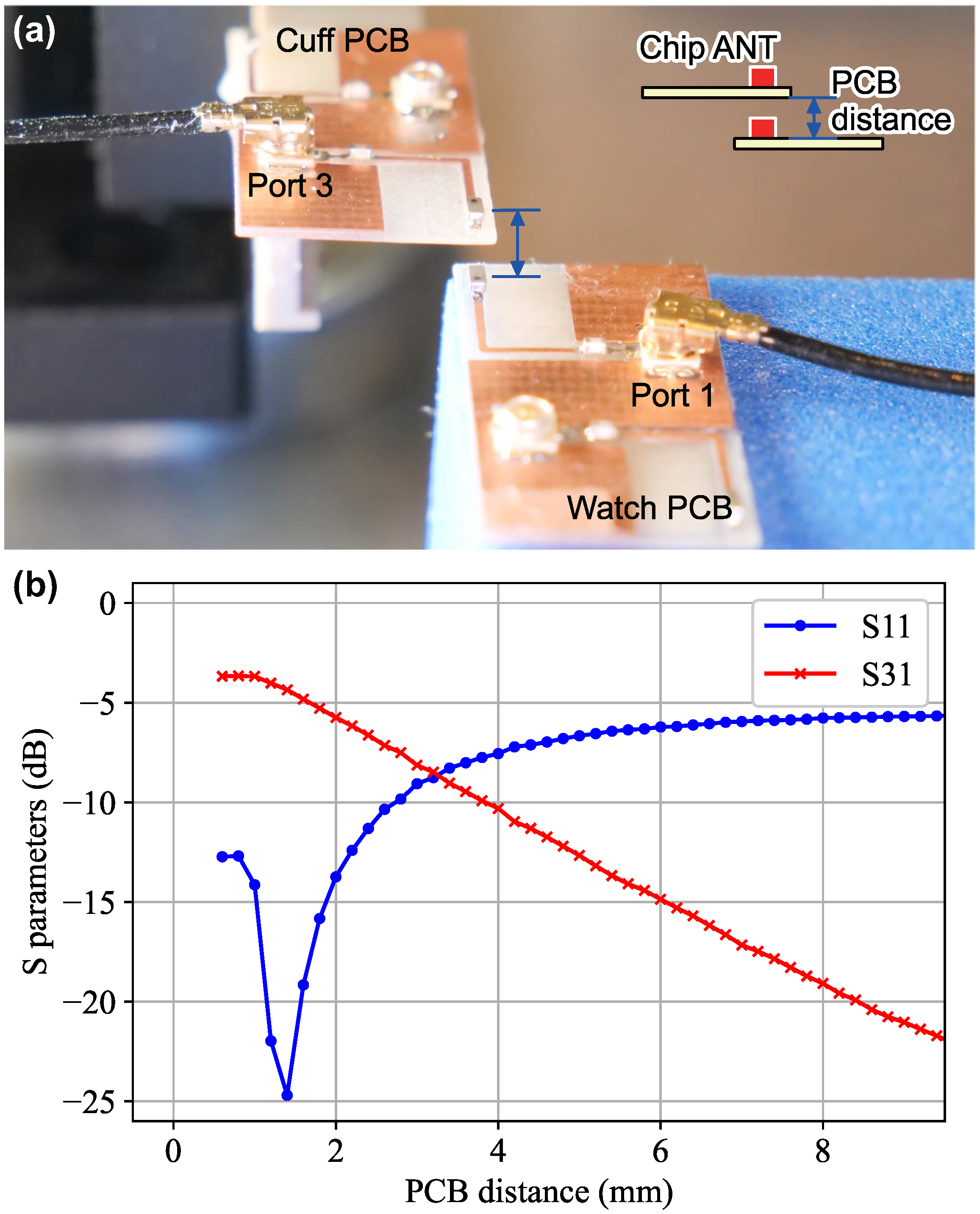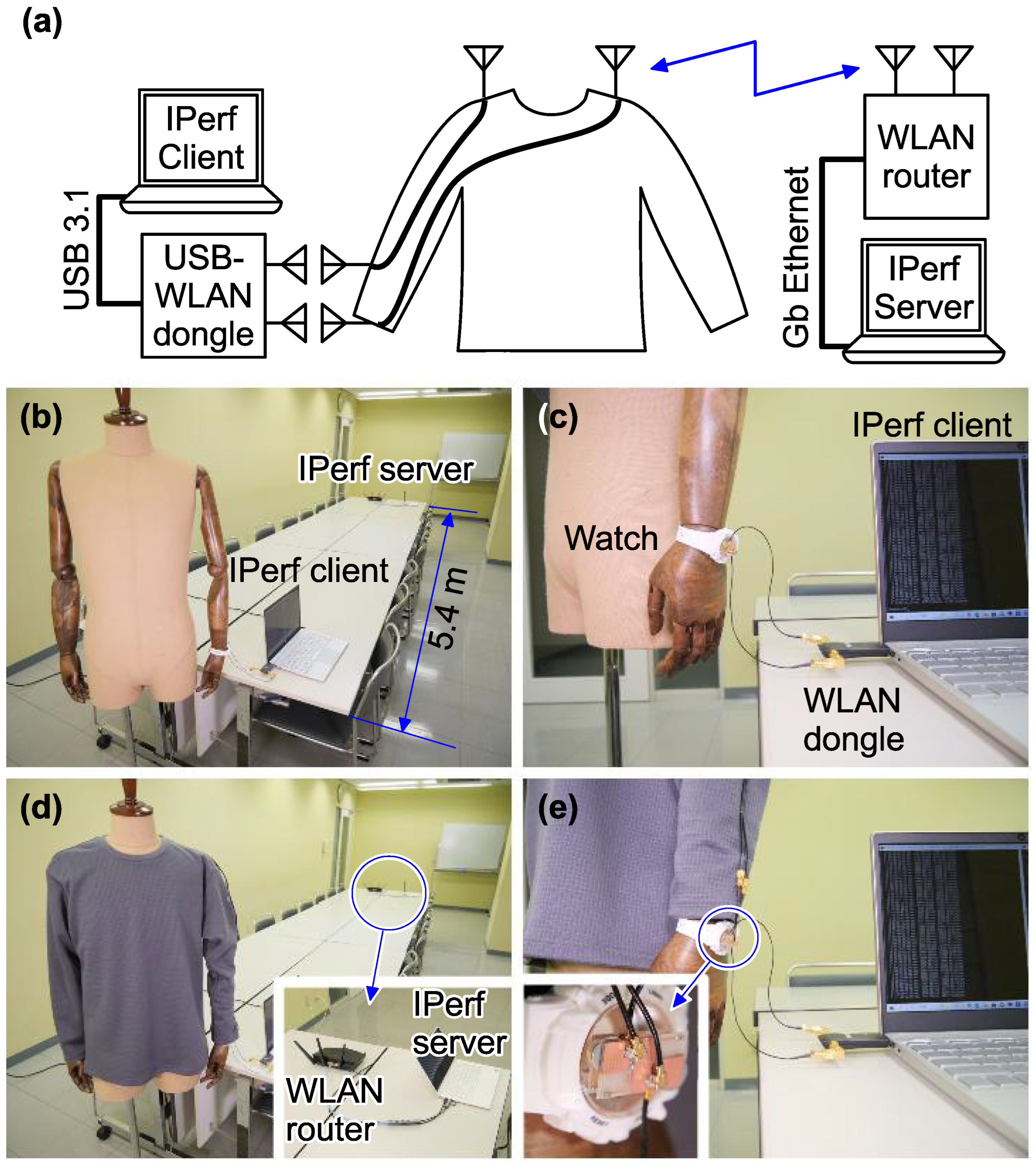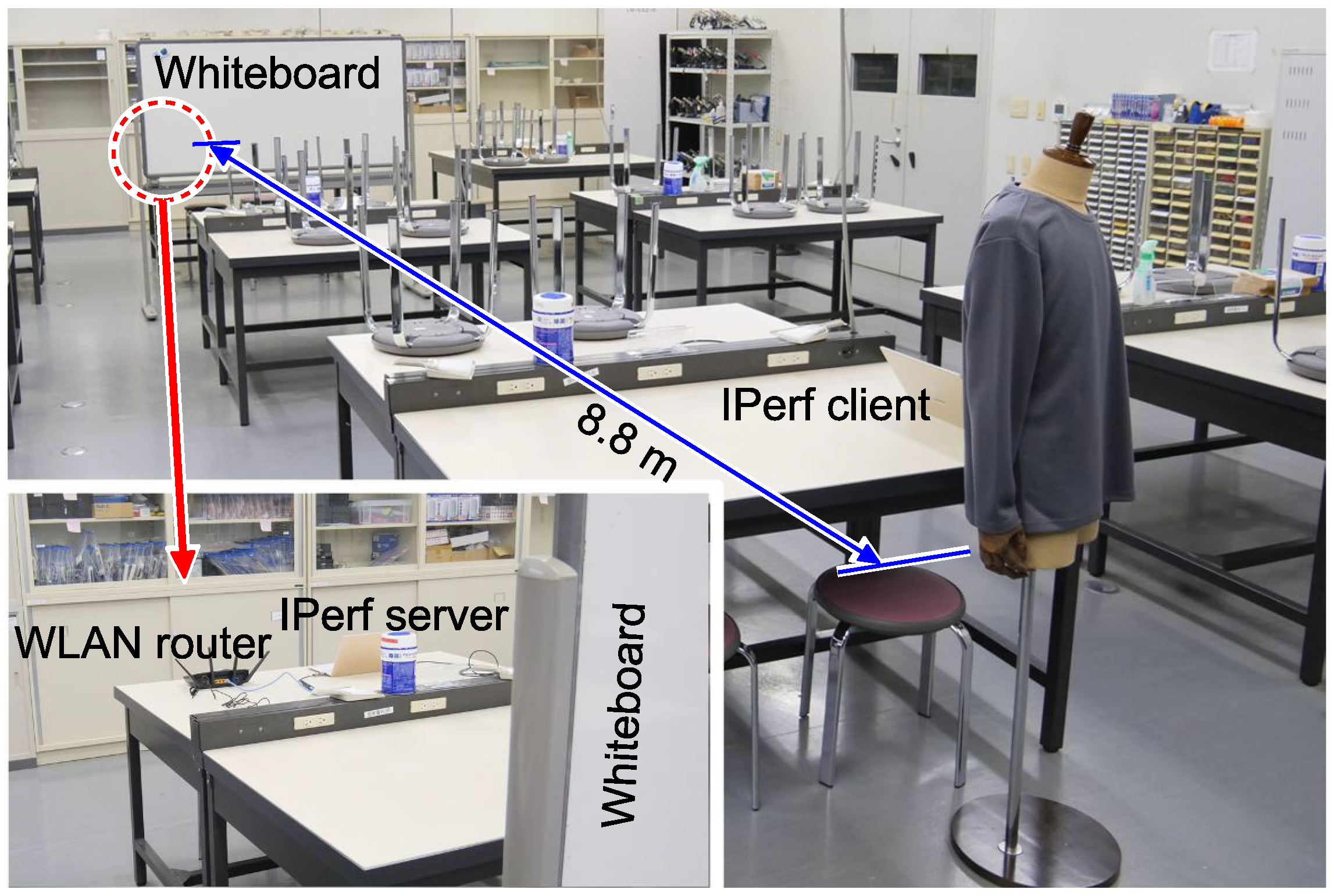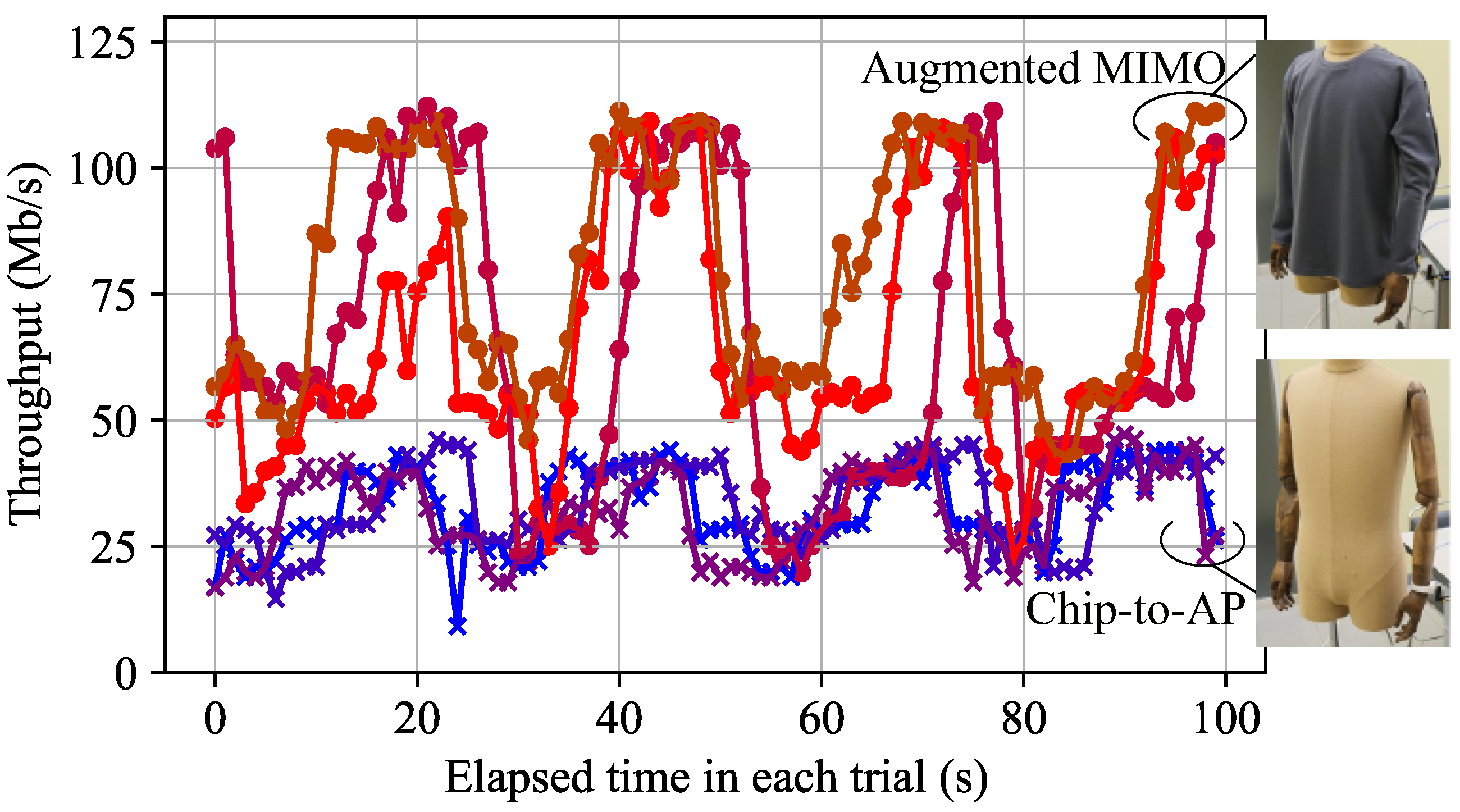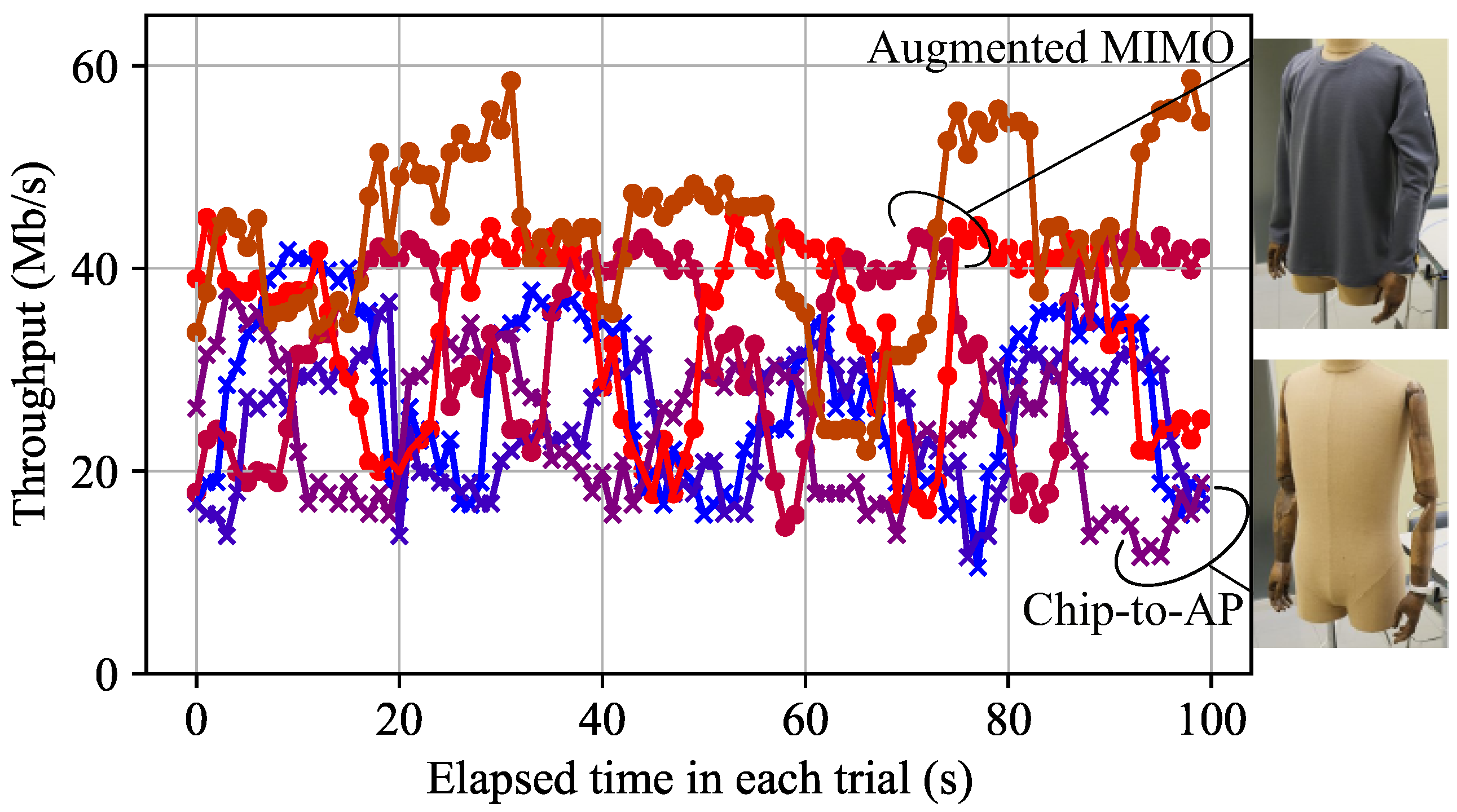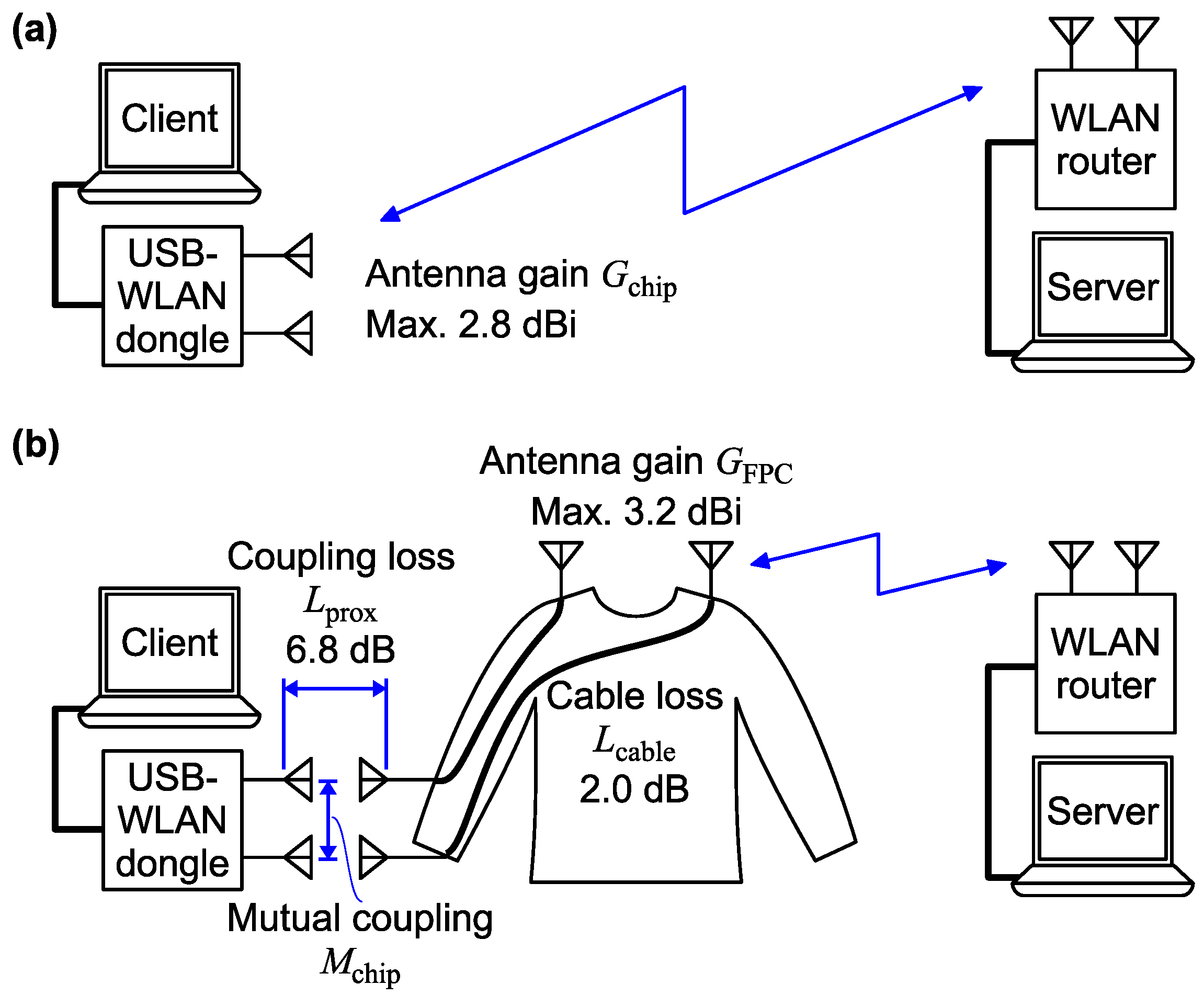1. Introduction
Multiple-input–multiple-output (MIMO) [
1], which uses multiple antennas at the transmitter and receiver, is now a common technique for increasing communication capacity without widening the occupied radio frequency (RF) bandwidth. A physical limitation of MIMO is that its effectiveness in improving channel capacity depends on the spatial correlation of the antennas. As a rule of thumb, a half-wavelength separation between antenna elements is required for sufficient antenna independence.
Antenna arrays within a deep subwavelength dimension degrade MIMO performance due to the increased mutual coupling and spatial correlation between the antenna elements [
2]. In particular, very small devices such as smartwatches encounter this problem. The 2.4 GHz industrial, scientific, and medical (ISM) band is widely used for a variety of wireless communications, including wireless local area networks (WLANs) and Bluetooth, which are used in most commercially available wearable devices. The free-space wavelength of radio waves in the band is about 12 cm. Therefore, the antenna array that can be embedded in wearable devices with a watch form factor or smaller must be of deep subwavelength. Without special antenna decoupling techniques, it has been reported that typical inverted-F antennas integrated into a 40 mm square scale, comparable to smartwatches, exhibit a mutual coupling of about
dB [
3]. To counter this problem, antenna decoupling techniques have been extensively investigated [
4].
Despite such a challenging issue, it has been clarified in the literature that even if the antenna spacing is reduced, increasing the number of antenna elements contributes to increasing the channel capacity [
5]. In addition, one of the key technologies for next-generation high-speed mobile networks is massive and ultra-massive MIMO [
6]. Thus, MIMO is an essential technology for mobile communication devices. The application of MIMO technology is also expanding to smaller scales; for example, investigations of implantable antennas [
7] and antenna-on-chip [
8] are in progress. Therefore, for the sustainable evolution of mobile wireless communication technologies, a wearable-friendly MIMO implementation technique is needed.
We propose Augmented MIMO, in which a larger antenna array with increased antenna spacing is mounted on the human body, to improve the MIMO performance of wearable devices with a physically constrained small form factor. The key idea is that, for such very small wearable devices, the wearer’s own body can be used as a spacious antenna fixture that always exists with oneself. Assuming the use of the 2.4 GHz ISM band, the human body is significantly larger than the wavelength. Therefore, the proposed scheme even opens avenues to implement massive MIMO antenna arrays with wearable devices, whose implementation is currently limited to base stations that have enough space to accommodate the large number of antennas.
It must be clarified that the proposed scheme is completely different from, but not exclusive to, other antenna decoupling techniques. We can find extensive research on this type of coupling reduction in size-limited MIMO applications [
4]. The state-of-the-art developments include isolation techniques based on additional parasitic elements [
9], characteristic modes [
10], electromagnetic band gap (EBG) [
11], and metamaterials [
12]. The proposed Augmented MIMO scheme provides a way to implement MIMO antenna arrays with sufficient spacing and reduced antenna coupling without relying on special decoupling techniques. On the other hand, when combined with decoupling techniques, the antenna density can be increased; therefore, the total number of antenna elements that can be implemented in clothing is significantly increased, thus paving the way for the implementation of massive MIMO systems in wearable devices.
An example of Augmented MIMO implementations, in contrast to conventional MIMO, is illustrated in
Figure 1. Here, we consider a MIMO link between a WLAN access point (AP) and a smartwatch. Two small chip antennas are embedded in the smartwatch, with a subwavelength spacing and, therefore, degraded antenna isolation. In the conventional MIMO system in
Figure 1a,
MIMO channels are established between the two chip antennas and two AP antennas. On the other hand, in the Augmented MIMO system shown in
Figure 1b, the dominant multipath MIMO channels are between the two shoulder-mounted antennas and two AP antennas. At the opposite end of the signal paths on the clothing, near the smartwatch, the signal is transferred between two pairs of proximity-coupled chip antennas. Each pair consists of one antenna belonging to the watch and the other to the clothing. Note that the chip antennas in the smartwatch are identical in both
Figure 1a,b. Therefore, Augmented MIMO only adds the antenna elements and signal paths with better isolation on the clothing, without disabling anything in the original antenna system.
A critical argument that arises with the Augmented MIMO system is whether MIMO performance is indeed improved, even with the closely spaced original MIMO antennas remaining in the signal paths. These antennas may reduce the rank of the MIMO channel, similar to a keyhole effect [
13], which degrades the MIMO channel capacity due to a rank-1 signal propagation section. The main contributions of this paper are (1) to introduce the idea that wearable antennas can be used to improve the MIMO performance of small wearable devices; (2) to present specific experimental results that support the validity of the idea, even if the device itself is not directly embedded/attached to clothing and is originally designed to operate in a standalone manner; and (3) to point out the factors that influence its effectiveness as a guide for future research.
In this paper, we empirically demonstrate the improvement in MIMO performance with a prototype of Augmented MIMO. In addition, several factors that influence the effectiveness of Augmented MIMO are discussed. The discussion will provide insight into the extensive work that can be conducted in the future on Augmented MIMO.
2. Principle: How Augmented MIMO Improves Channel Capacity
Here, we consider an
Augmented MIMO system, i.e., we assume an equal number
N of transmitter antennas and receiver antennas.
Figure 1b is an example of
. The channel capacity depends on the signal-to-noise ratio (SNR) at the receiver and the channel correlation. When the channel state information is not shared between the transmitter and receiver, the channel capacity
C (per unit bandwidth) is formulated as [
1]
where
denotes the average SNR at each receive antenna,
H represents the channel,
is its conjugate transpose, and
are the non-negative real eigenvalues of the Wishart matrix
.
is the
identity matrix. For higher channel correlations, each of the
values decreases. When one of the eigenvalues becomes significantly smaller than the others and is practically considered to be zero, the rank of
W decreases, i.e., the number of terms actually summed in (
1) decreases.
The idea of Augmented MIMO is to avoid a reduction due to closely spaced antennas by extending the substantive locations of the MIMO antennas outside the small device itself. Therefore, Augmented MIMO is expected to improve the channel capacity of a wearable MIMO transceiver that faces mutual antenna coupling due to its size limitation. Note that it is not expected to be effective for MIMO systems that originally achieve large eigenvalues.
6. Discussion
6.1. Antenna Gain and Antenna Correlation
The antenna gains and losses in the chip-to-AP link and the Augmented MIMO link of our experiment are depicted in
Figure 11.
Taking the losses into account, the overall gain of each antenna of Augmented MIMO is formulated in dB as follows:
In the experiment,
dB, and
dB at 2.45 GHz. Although
and
depend on direction and polarity, the maximum values of these gains shown in the datasheets [
14,
17] are approximately 3 dBi and roughly equal. Therefore, we assume
, and then,
becomes approximately 9 dB lower than the original chip antenna gain
. Despite the reduced antenna gain, i.e.,
, the throughput was significantly improved by a factor of 2 or more in the LOS environment.
Assuming a constant noise level, the received signal strength determines the SNR; then, the antenna gain determines the SNR for a fixed transmit power. Decreasing the overall antenna gain with Augmented MIMO reduces the SNR at the receiver.
The channel capacity depends on the SNR at the receiver and the channel correlation, as described in
Section 2. The experimental system is the case of
in (
1). Higher channel correlations reduce
and
, which can cause the rank of
to be 1. Lower antenna gains reduce the SNR
at the receiver. Hence, whether antenna gain or antenna correlation is dominant depends on other factors.
The experiment results of increased throughput indicate that the increase in
in (
1), i.e., the antenna correlation reduction, contributed more than the reduction in SNR
. The distance between the transmitter and the receiver was relatively short, 5.4 m, and the channel included the LOS path as shown in
Figure 7b; therefore, the SNR may have been relatively high for both chip-to-AP and Augmented MIMO compared to typical WLAN use cases. This high SNR condition may have reduced the influence of the antenna gain reduction in the Augmented MIMO link.
In the NLOS experiment, Augmented MIMO also improved throughput, but the ratio of its throughput to that of the chip-to-AP link dropped to 1.5. The SNR in the NLOS experiment is considered to be lower than that in the LOS experiment due to the blocked direct path and the longer distance between the transmitter and receiver.
The conditions for Augmented MIMO to improve the channel capacity need further investigation, and the limitations of Augmented MIMO should be clarified in future work.
6.2. Mutual Coupling in Original Antenna Array
The mutual coupling
in
Figure 11, i.e.,
in
Figure 2, is one of the dominant factors determining
W. If
approaches 0 dB, it means that a chip antenna is transferring the signal to the other chip antenna rather than radiating it to the air; thus, it is virtually a single-antenna transceiver. This is interpreted as rank
. In this case, Augmented MIMO cannot contribute to increasing the channel capacity.
In our experiment, the mutual coupling was about dB, and the proximity coupling () was about dB. The condition means that the signal fed to one of the watch antennas is transferred more to the proximity-coupled cuff antennas than to the other watch antenna. This may have had a positive impact on the throughput improvement with Augmented MIMO.
Acceptable conditions for
and
should be further investigated in future work. In addition, as we have seen in
Figure 6, the proximity coupling can also be further increased by design optimization.
6.3. Cuff Antennas Influencing the Characteristics of Original Chip Antenna
Comparing
Figure 2b and
Figure 5b, we can see the influence of the proximity coupling of the cuff antenna array on the watch antenna characteristics. The resonant frequency is slightly lowered, and the minimum value of
is reduced. It may also have influenced the antenna radiation patterns as reported in the literature [
2], although we did not evaluate this.
Intuitively, the characteristic changing effects will be more significant with stronger proximity coupling. To increase the overall antenna gain
in (
3), the proximity coupling loss
should be reduced, which requires stronger coupling. However, stronger coupling changes the
frequency characteristics; therefore, the return loss may increase. In our design,
increased when the spacing was less than 1 mm, as shown in
Figure 6, although
did not decrease. The increase in
can generally lead to an increase in
.
This trade-off should be addressed in future work.
6.4. Practical Textile-Based Implementation
The Augmented MIMO clothing was prototyped using a commercially available 2.8 mm thick coaxial cable with acceptable flexibility for application in clothing. However, considering more realistic use cases where cables are frequently bent, twisted, and stretched, the durability of the cable is a critical issue. In addition, washability is another important factor for daily use.
From this point of view, the implementation of the system by integrating textile-based signal transmission media into a flexible textile, but not by cables attached outside the clothing, will be explored in future work. Related works found in the literature include coaxial cables [
20], microstriplines [
21], metamaterial transmission lines [
22], and 2-D waveguides [
23]. The integration of commercially available ultra-thin coaxial cables into flexible textiles is also an option, as such an implementation with machine washability has been reported [
24]. In particular, the development of practical structures that achieve lower losses
with higher flexibility and durability will be of great interest. The magnitude of loss that can be acceptable is also an essential issue, and is related to the discussion in
Section 6.1.
6.5. On-Body Antenna Locations and Isolation from Body
In the experiment, the FPC antennas were located at the shoulders. This antenna location is reasonable to avoid the shadowing effect by the user’s body itself and other furniture, assuming the access point is to be installed at a high position, such as near the ceiling, in daily indoor use cases. From this point of view, it is preferable to place the antenna close to the head.
On the other hand, for safety reasons, it is preferable to avoid RF radiation around the head [
25]. In terms of the actual power radiated from the antennas, the antenna system implemented in clothing is completely passive and lossy; therefore, the power radiated from the shoulder antennas is less than that of the original watch antenna. However, safety, especially the user’s sense of security, depends not only on the absolute power but also on the factor of how close the radiating element is to the head. With regard to this factor, the Augmented MIMO scheme has a degree of freedom to choose antenna locations preferred by the users.
Thus, the appropriate antenna location on the clothing depends on the application and the user and is controversial; therefore, future research on this aspect is required; for example, psychophysical experiments with a large number of subjects.
Even for antennas away from the head, the backward radiation to the human body, causing safety issues and the degradation of antenna efficiency, is a common problem for wearable antennas. Reducing these unwanted effects by metamaterials is a promising approach [
26], and extensive future research is expected.
7. Conclusions
In this paper, the concept of Augmented MIMO was proposed, and its effectiveness was empirically demonstrated. The experimental results demonstrate the throughput improvement with the proposed scheme, even if the overall antenna gain decreases with the external body-mounted antennas. The experimental results prove the existence of scenarios wherein the Augmented MIMO increases the channel capacity; however, its effectiveness depends on several factors, as discussed above.
The advantages of the proposed scheme include the following: (1) a significant improvement in MIMO performance due to high diversity gain; (2) a high degree of freedom in antenna placement; and (3) room for increasing the number of antennas toward massive MIMO. However, the proposed scheme features various issues that do not arise in conventional MIMO systems, such as the following: (1) the stability of proximity coupling between wearable devices and clothing; (2) the comfort of users wearing the antenna-distributed clothing; and (3) the durability of the clothing. Further detailed investigations that include theoretical aspects and practical system integration methods are needed to overcome these issues.
The proposed scheme can also be applied to multiband/wideband MIMO systems, although the experiment was designed for single-band operation for simplicity. This work contributes to the future development of yet another scheme to improve the communication performance of small wearable devices by using the human body as a spacious antenna fixture.




